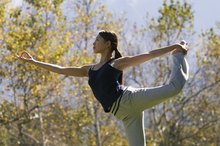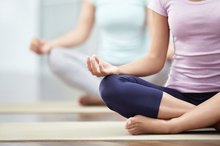Why Are My Thigh Muscles Getting Tight?
Muscle tightness, or a lack of flexibility, in your thighs is common if you are active but overtraining your quadriceps. Your thighs can also become tight if you neglect your post workout cooldown stretching. Women in particular are prone to tight thighs because they do not utilize their gluteal muscles as efficiently to stabilize and create movement at the hip and knee.
Lack of Flexibility
As you work out, your thigh muscles must constantly repair themselves so that they can meet the demands of training. This results in improved performance but can result in a loss of flexibility. Muscle fibers repair themselves more tightly knit to each other which create tighter muscles over time. The first step in addressing this issue is to restore the optimal length-tension relationship to the quadriceps muscles of the thigh. You can do this by performing a 10 to 15 minute of stretching exercises for your quadriceps after your leg workouts. You should hold each stretch 30 to 60 seconds and alternate between legs to ensure each leg is stretched evenly.
- As you work out, your thigh muscles must constantly repair themselves so that they can meet the demands of training.
- You can do this by performing a 10 to 15 minute of stretching exercises for your quadriceps after your leg workouts.
Improper Muscle Balance
Muscles Involved in Hip Flexion
Learn More
Working out your quadriceps with resistance training or through running causes your quads to develop significantly faster than your hamstrings. This will improve your quadriceps strength but can reduce your ability to activate your hamstring muscles at proper levels. This creates a constant reinforcement of “quad dominance;” therefore, exercises to strengthen your hamstrings must be performed to restore balance to the musculature of your upper leg. A good rule of thumb is to use two hamstring exercises for each quadriceps exercise in your resistance training program if you are having problems with tight thighs.
- Working out your quadriceps with resistance training or through running causes your quads to develop significantly faster than your hamstrings.
- A good rule of thumb is to use two hamstring exercises for each quadriceps exercise in your resistance training program if you are having problems with tight thighs.
Glute Utilization
Your gluteal, or butt, muscles are responsible for extension of your hip in movement such as climbing stairs or standing up out of a chair. Unfortunately, constantly sitting in a chair or the development of high levels of quad strength through exercise can cause your quadriceps to “take over” for your glutes during these movements. This reinforces quad tightness because they are will now have to work more often unless strength in your glutes is restored. Utilize exercises such as the hip bridge and glute-ham raise to restrengthen weakened glute muscles. When your glute strength is restored, your glutes will better be able to assist your quadriceps and cause your quadriceps to be used less.
- Your gluteal, or butt, muscles are responsible for extension of your hip in movement such as climbing stairs or standing up out of a chair.
- Unfortunately, constantly sitting in a chair or the development of high levels of quad strength through exercise can cause your quadriceps to “take over” for your glutes during these movements.
Addressing the Problem
How to Strengthen the Patella Tendon
Learn More
Taking care of tight quadriceps is an urgent issue for any athlete, runner or individual experiencing muscularly related knee pain. You can reduce your risk of ACL injury by stretching tight quadriceps muscles and restoring strength to your hamstring and gluteal muscles. Poor flexibility in your thighs is also associated with patellar tendonitis and poor iliotibibial band, IT-band, tracking which can cause pain in your knee joint. Before implementing changes in your workout routine to address quadriceps tightness, consult with your doctor to ensure these methods of training are safe for you to perform and that your knee pain stems from quadriceps tightness and not a more serious condition.
- Taking care of tight quadriceps is an urgent issue for any athlete, runner or individual experiencing muscularly related knee pain.
- Before implementing changes in your workout routine to address quadriceps tightness, consult with your doctor to ensure these methods of training are safe for you to perform and that your knee pain stems from quadriceps tightness and not a more serious condition.
Related Articles
References
- American Council on Exercise: ACE Lists Top Ten Reasons to Stretch
- "ACSM's Resources for the Personal Trainer"; 2007
- "Principles of Manual Sports Medicine;" Steven Karageanes; 2005
- MedLine Plus: Knee Pain
- Wilkerson R. American Academy of Orthopaedic Surgeons. Quadriceps tendon tear. Updated February 2016.
- Caylor D, Fites R, Worrell TW. The relationship between quadriceps angle and anterior knee pain syndrome. J Orthop Sports Phys Ther. 1993;17(1):11-6. doi:10.2519/jospt.1993.17.1.11.
- Lavine R. Iliotibial band friction syndrome. Curr Rev Musculoskelet Med. 2010;3(1-4):18-22. doi:10.1007/s12178-010-9061-8.
- Rainville J, Jouve C, Finno M, Limke J. Comparison of four tests of quadriceps strength in L3 or L4 radiculopathies. Spine. 2003;28(21):2466-71. doi:10.1097/01.BRS.0000090832.38227.98.
- Sekir U, Gür H. A multi-station proprioceptive exercise program in patients with bilateral knee osteoarthrosis: functional capacity, pain and sensoriomotor function. A randomized controlled trial. J Sports Sci Med. 2005;4(4):590-603.
- Çelik, D., Argut, S. K., & Kılıçoğlu, Ö. (2017). The effectiveness of quadriceps strengthening exercises combined with Neuromuscular Electrical Stimulation on patellofemoral pain syndrome: Pilot study. Physical Therapy in Sport, 28, e16.
- Lichtenstein, A. H., & Fine, J. (2017). Quadriceps Te ars and Tendon Ruptures. In Musculoskeletal Sports and Spine Disorders (pp. 277-279). Springer, Cham.
Resources
- "NSCA's Essentials of Personal Training"; Roger Earle and Thomas Baechle; 2003
- "NASM Essentials of Personal Fitness Training"; April 2007
Writer Bio
Joshua Bailey has been writing articles since 2006 with work appearing at Bodybuilding.com and 2athletes.com. Bailey holds the following certifications: NASM-CPT, NASM-PES, NASM-CES and NSCA-CSCS. He also holds a Bachelor of Science in exercise and sports science from the University of North Carolina, Chapel Hill and a Master of Science in exercise physiology from the University of North Carolina, Greensboro.






